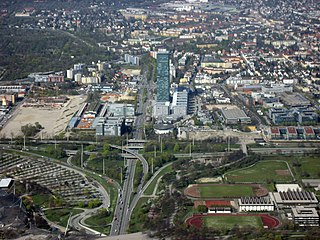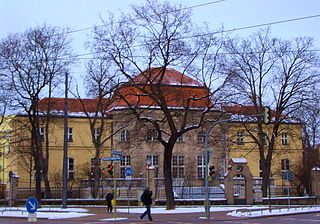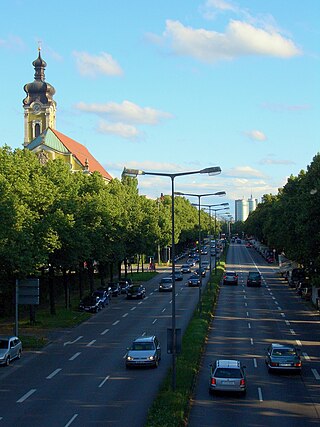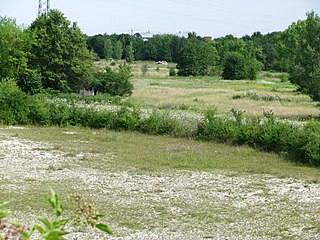
Am Hart is the northernmost of the three sub-districts of the Munich city district 11 Milbertshofen-Am Hart.

The McGraw Kaserne is a former military installation in southern Munich, Germany, which was used by the U.S. Military during the occupation of Germany after World War II. The main building was one of the first ones in Germany to be built using steel frame technology. The kaserne was named after PFC Francis X. McGraw.

The Maximilian-II-Kaserne respectively Max-II-Kaserne was a military facility in Munich, Germany, which was completed in 1865. The kaserne was named after Maximilian II of Bavaria.

The Ernst-von-Bergmann-Kaserne, before called Warner Kaserne by the US Army (1950-1968), it is a military facility in Munich, Germany, which was built by the architect Oswald Bieber between 1934 and 1936. The current name was given in honor of professor Ernst von Bergmann.
Fürst-Wrede-Kaserne has been a military facility in Munich, Germany, since 1936 when it was built by the Munich Heeresbauamt under its original name Verdun-Kaserne. After World War II the U.S. forces renamed it Will Kaserne, and the Bundeswehr renamed it once more in honor of Karl Philipp von Wrede on 17 April 1972.
The Bayern-Kaserne is a military facility in Munich, Germany, originally named General-Wever-Kaserne. The facility was constructed between 1936 and 1938. After World War II it was renamed by the United States forces to Henry Kaserne in honor of Private Robert T. Henry. When it was transferred to the German Bundeswehr, it was renamed once more in honor of General Walther Wever on 9 October 1969.
The Luitpoldkaserne, originally Luftschifferkaserne, was a kaserne at Infanteriestraße 19 in Munich, Germany, which was built after 1896 to accommodate the air skippers unit of the Bavarian army, which was disposed in 1890.

The Hofgartenkaserne, also known as Infanterie-Leibregiment-Kaserne or Max-Joseph-Kaserne, was a military facility of the Bavarian army, located at Hofgarten Strasse 2 in Munich, Germany. The construction was planned and realized by the war economy councillor Direktorialrat Joseph Frey from 1801 to 1807.

The Seidenhauskaserne, also called Artillerie-Kaserne, was a small military facility of the Bavarian army, located at Hofgarten Strasse 1 in Munich, Germany, which existed from 1808 until 1899.

Neuhausen and Nymphenburg were boroughs of Munich, the capital of the German state of Bavaria. They were merged into the borough 09 - Neuhausen-Nymphenburg in 1992. For further information on the Munich boroughs, see: Boroughs of Munich.

The Dachauer Straße is the longest street in Munich with a length of 11.2 km and it received its name since it is the connecting road to Dachau Palace. In the north of Munich, it is part of the Bundesstraße 304.

Moosach is the 10th northwestern district of Munich, Bavaria, Germany. It is sectioned in the urban districts Hartmannshofen, Pressestadt and Borstei.
Railway troops are soldiers who are also railway engineers. They build, repair, operate or destroy militarily relevant railway lines and their associated infrastructure.
The Winzererstraße is a two-kilometer-long street in the Munich districts of Maxvorstadt and Schwabing.
Lothstraße is a roughly 1.3 kilometer long street in Munich. It runs through the St. Benno district and forms the boundary between the municipality of Maxvorstadt, which lies southeast of the street, and the districts of Neuhausen and Schwabing-West, which are located northwest.

The Schwere-Reiter-Straße is a 1.2 km long street in Munich's Schwabing-West district in the Oberwiesenfeld area. It leads from Leonrodplatz to the Hohenzollernstraße on the corner of Winzererstraße, where it branches off to the north of the Ackermannstraße. North is the Olympic Park.

The Landshuter Allee is an avenue in Munich and through most of its course it is part of the Mittlerer Ring, the Bundesstraße 2 R. It joins Donnersbergerbrücke at Arnulfstraße in the Neuhausen district and runs from Dachauer Straße west of the Olympiapark to Moosacher Straße west of the Olympic village in the Moosach district. The B 2R leaves the intersection-free avenue at the Landshuter Allee and continues on the Georg-Brauchle-Ring. The Landshuter Allee now functions as the B 304 and connects the Mittlerer Ring with the northern tangent of the Outer Ring, which is only partially complete. The large width of the Landshuter Allee of 54 metres between the houses is striking. It crosses the Nymphenburg-Biedersteiner Kanal.

The Virginia depot was a military camp used last by the Bundeswehr west of Schleißheimer Straße in the Munich district of Lerchenau. Today it is a biotope with rare plant species.

Leonrodplatz is a square in the Munich district of Neuhausen. It was named in 1927 after the former Bavarian Minister of Justice Leopold von Leonrod.














